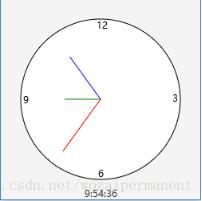JavaFX时钟效果 JavaFX实现简易时钟效果
为大家详细 人气:1首先要在面板中显示一个时钟,我们可以设计一个ClockPane类来显示一个时钟。
最终效果:

若要绘制一个时钟,需要绘制一个圆并为秒钟、分钟和小时绘制三个指针。为了画一个指针,需要确定一条直线的两端:一端是时钟的中央,位于(centerX,centerY);另外一端位于(endX,endY),由一下公式来确定:
endX=centerX+handLength×sin(θ)
endY=centerY-handLength×cos(θ)
(其中θ是指针和竖直方向12点的夹角)
因为一分钟有60秒,所以第2个指针的角度是:second×(2π/60)
分钟的位置由分钟和秒钟来决定。包含秒数的确切分钟数是minu+second/60。例如,如时间是3分30秒,那么总的分钟数就是3.5。由于一小时有60分钟,因此分针的角度是: (minute+second/60)×(2π/12)
由于一个圆被分为12个小时,所以时针的角度是: (hour+minute/60+second/(60×60))×(2π/12)
为了简化计算,在计算分针和时针角度的时候,可以忽略秒针,因为它们数字太小,基本可以忽略。因此,秒针、分针以及时针的端点可以如下计算:
secondX = centerX + secondHandLength × sin(second × (2π/60))
secondY = centerY - secondHandLength × cos(second × (2π/60))
minuteX = centerX + minuteHandLength × sin(minute × (2π/60))
minuteY = centerY - minuteHandLength × cos(minute × (2π/60))
hourX = centerX + hourHandLength × sin((hour+minute/60) × (2π/12))
hourX = centerX + hourHandLength × sin((hour+minute/60) × (2π/12))
这样就得到了ClockPane类的实现程序:
package com.company;
import javafx.scene.layout.Pane;
import javafx.scene.paint.Color;
import javafx.scene.shape.Circle;
import javafx.scene.shape.Line;
import javafx.scene.text.Text;
import java.util.Calendar;
import java.util.GregorianCalendar;
public class ClockPane extends Pane{
private int hour;
private int minute;
private int second;
private double w=250,h=250;
public ClockPane() {
setCurrentTime();
}
public ClockPane(int hour,int minute,int second) {
this.hour=hour;
this.minute=minute;
this.second=second;
paintClock();
}
public int getHour() {
return hour;
}
public void setHour(int hour) {
this.hour=hour;
paintClock();
}
public int getMinute() {
return minute;
}
public void setMinute(int minute) {
this.minute=minute;
paintClock();
}
public int getSecond() {
return second;
}
public void setSecond(int second) {
this.second=second;
paintClock();
}
public double getW() {
return w;
}
public void setW(double w) {
this.w=w;
paintClock();
}
public double getH() {
return h;
}
public void setH(double h) {
this.h=h;
paintClock();
}
public void setCurrentTime() {
Calendar calendar=new GregorianCalendar();
this.hour=calendar.get(Calendar.HOUR_OF_DAY);
this.minute=calendar.get(Calendar.MINUTE);
this.second=calendar.get(Calendar.SECOND);
paintClock();
}
protected void paintClock() {
double clockRadius=Math.min(w,h)*0.8*0.5;
double centerX=w/2;
double centerY=h/2;
Circle circle=new Circle(centerX,centerY,clockRadius);
circle.setFill(Color.WHITE);
circle.setStroke(Color.BLACK);
Text t1=new Text(centerX-5,centerY-clockRadius+12,"12");
Text t2=new Text(centerX-clockRadius+3,centerY+5,"9");
Text t3=new Text(centerX+clockRadius-10,centerY+3,"3");
Text t4=new Text(centerX-3,centerY+clockRadius-3,"6");
double sLength=clockRadius*0.8;
double scondX=centerX+sLength*Math.sin(second*(2*Math.PI/60));
double scondY=centerY-sLength*Math.cos(second*(2*Math.PI/60));
Line sline=new Line(centerX,centerY,scondX,scondY);
sline.setStroke(Color.RED);
double mLength=clockRadius*0.65;
double minuteX=centerX+mLength*Math.sin(minute*(2*Math.PI/60));
double minuteY=centerY-mLength*Math.cos(minute*(2*Math.PI)/60);
Line mline=new Line(centerX,centerY,minuteX,minuteY);
mline.setStroke(Color.BLUE);
double hLength=clockRadius*0.5;
double hourX=centerX+hLength*Math.sin((hour%12+minute/60.0)*(2*Math.PI/12));
double hourY=centerY-hLength*Math.cos((hour%12+minute/60)*(2*Math.PI/12));
Line hline=new Line(centerX,centerY,hourX,hourY);
hline.setStroke(Color.GREEN);
getChildren().clear();
getChildren().addAll(circle,t1,t2,t3,t4,sline,mline,hline);
}
}
对程序的简要解读:①Java API的GregorianCalendar类可以使用它的无参构造方法来商城一个具有当前时间的Calendar实例。可以从一个Calendar对象,通过调用它的get(Calendar.HOUR)、get(Calendar.MINUTE)和get(Calendar.SECOND)方法来返回小时、分钟以及秒钟。②因为paintClock()方法在任何一个新的属性(hour、minute、second、w以及h)被设置的时候调用,所以之前的内容从面板中被清除。
然后就需要设计一个ClockAnimation类来显示时钟的动画
Timeline类可以用于通过使用一个或者更多的KeyFrame(关键帧)来编写任意动画。
你可以用Timeline来控制时钟的重绘,代码如下:
package com.company;
import javafx.animation.Timeline;
import javafx.application.Application;
import javafx.geometry.Pos;
import javafx.scene.Scene;
import javafx.scene.layout.BorderPane;
import javafx.stage.Stage;
import javafx.util.Duration;
import javafx.event.ActionEvent;
import javafx.event.EventHandler;
import javafx.animation.KeyFrame;
import javafx.scene.control.Label;
public class ClockAnimation extends Application {
@Override
public void start(Stage primaryStage) {
ClockPane clock=new ClockPane();
BorderPane borderPane=new BorderPane();
EventHandler<ActionEvent> eventHandler=e -> {
clock.setCurrentTime();
String timeString=clock.getHour()+":"+clock.getMinute()+":"+clock.getSecond();
Label lblCurrentTime=new Label(timeString);
borderPane.setCenter(clock);
borderPane.setBottom(lblCurrentTime);
BorderPane.setAlignment(lblCurrentTime, Pos.TOP_CENTER);
};
Timeline animation=new Timeline(new KeyFrame(Duration.millis(1000),eventHandler));
animation.setCycleCount(Timeline.INDEFINITE);
animation.play();
Scene scene=new Scene(borderPane,250,250);
primaryStage.setTitle("ClockAnimation");
primaryStage.setScene(scene);
primaryStage.show();
borderPane.widthProperty().addListener(ov ->
clock.setW(borderPane.getWidth())
);
borderPane.heightProperty().addListener(ov ->
clock.setH(borderPane.getHeight())
);
}
}
程序简单解读:①在时间线动画的每个关键帧中,这个处理器每秒被调用一次。所以动画中的时间每秒被更新一次。②最后两个监听器是用来修改时钟的面板的大小的,将这个监听器和窗体的宽度和高度属性进行注册,从而在场景的宽度和高度改变的情况下可以重新设置面板大小。代码保证了时钟面板的大小和场景大小是同步的。
最后运行就能达到上面图所示的效果了。
加载全部内容